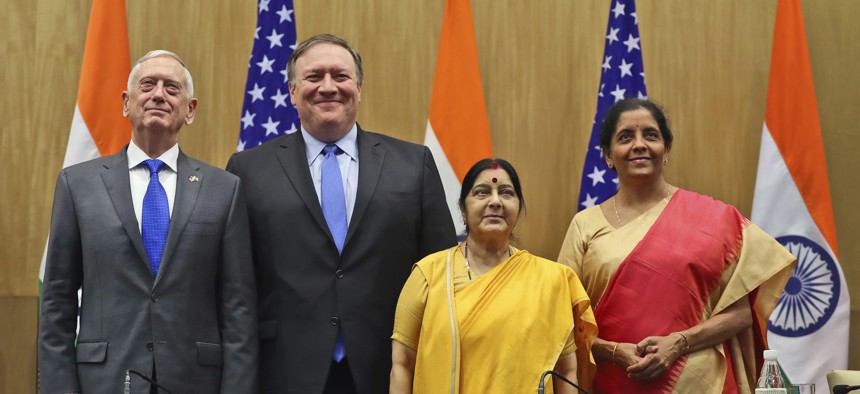
U.S. Defense Secretary James Mattis, U.S. Secretary of State Mike Pompeo, Indian Foreign Minister Sushma Swaraj and Indian Defense Minister Nirmala Sitharaman pose after making a joint statement after the "2+2" meeting in New Delhi, India, Sept. 6, 2018. AP Photo/Manish Swarup
What Next for US-India Military Ties?
A new agreement between top U.S. and Indian officials will deepen military cooperation and bolster strategic ties between the two countries.
This week, U.S. Secretary of State Mike Pompeo and Secretary of Defense Jim Mattis met with their Indian counterparts, External Affairs Minister Sushma Swaraj and Defense Minister Nirmala Sitharaman, reaching a number of new defense-related agreements.
More From Our ExpertsAlyssa AyresBackground Brief: Meet the U.S.-India “2+2”Michael P. DempseyState of U.S. Security: A Conversation with CFR's National Intelligence FellowPaul B. StaresPreventive Engagement
Despite major remaining hurdles on trade and Indian defense purchases from Russia, it’s a step forward for the U.S.-India security relationship.
In New Delhi, the “two-plus-two” dialogue was at long last able to complete an agreement to enhance communications sharing on defense platforms—something called the Communications Compatibility and Security Agreement, or COMCASA. It will allow India access to more advanced communications technology for defense equipment purchased from the United States, and as a result will also make it easier for India and the United States, as well as U.S. allies with similar equipment, to coordinate more fully in real time (or, in defense speak, enhance interoperability). It’s been under negotiation for years, so this achievement deserves praise.
Naval exchanges, counterterrorism cooperation, and North Korea
The two plus two produced several other important advances:
- A new “tri-services exercise,” increasing the complexity of military cooperation.
- More military personnel exchanges, and in particular a new exchange between the U.S. Navy’s Central Command and the Indian Navy. This will help deepen their naval cooperation across Asia, especially in light of the United States’ and India’s very different conceptions of how they delineate the Indo-Pacific.
- A new agreement on defense innovation.
- The reaffirmation of existing areas of agreement on counterterrorism and cybersecurity. The joint statement calls on Pakistan to do more to stop terrorism emanating from territory under its control and pledges more cooperation in cyberspace and more support for an “Afghan-owned, Afghan-led” peace process.
- The launch of secure hotlines between Pompeo and Swaraj, and Mattis and Sitharaman, building on the high-level hotlines established in the Obama administration.
Also of interest in the joint statement is the brief paragraph on North Korea, which included a pledge “to work together to counter North Korea’s weapons of mass destruction programs and to hold accountable those countries that have supported them.” North Korea has not traditionally been an area of significant U.S.-India cooperation, so it will be interesting to see where this leads.
Missing pieces and next steps
Absent from the statements were any details on U.S.-India trade frictions, but given the security focus of the two plus two, this should not surprise. The U.S.-India Trade Policy Forum, which will meet in November, is a more apt venue for technical discussion of trade issues.
Also absent were any resolutions on two thorny issues: first, whether President Donald J. Trump will provide a waiver to India for its long-in-the-works purchase of a Russian air defense missile system, thus avoiding sanctions that could result from the Countering America’s Adversaries Through Sanctions Act (CAATSA) legislation focused on Russia, and second, what will happen with U.S. sanctions and India’s oil procurement from Iran. Despite the dialogue’s progress, these questions will continue to hover over the security relationship for the time being.
This piece, first published by the Council on Foreign Relations, is used with permission.
NEXT STORY: Russia Can Stop a Slaughter in Idlib





